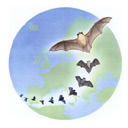Bats! A Valuable Resource
One recent morning I was listening to a morning radio show in Omaha where the topic centered on bats. It seems the Health Department and Humane Society in Omaha had received more than its usual calls about bats entering peoples houses. In a two week period they had received 65 calls, more than they receive in an average year. The discussion ranged from fears and concerns to an interest and support of bat populations.

What is it about bats that so many people fear? Most obvious is they are misunderstood. They are mysterious creatures of the night and used to portray evil during Halloween. There is also the misconception that all bats have rabies, and they will fly into your hair and become entangled. All these myths, as well as many others, have given our bats a bad rap.
Bats are actually the most gentle of all mammals. They are also the most populace of mammals on the planet. Unfortunately their numbers are in concerning decline primarily due to the use of pesticides. There has never been a confirmed bat attack on a human, nor do they fly into a persons hair. As for rabies, bats are not a host for the virus. If they contract rabies they first become paralyzed followed by death. So if all bats had rabies, there would be no bats. People that are bitten by bats usually find a bat on the ground and attempt to pick them up or touch them. However, if you find a bat on the ground more than likely it is sick and precautions should be taken. The reality of it is any animal, domestic or wild, will bite if it feels threatened. As for bats? Your chances of contracting rabies from them is extremely rare. Your chances of getting struck by lightening, hit by a car, falling down a flight of stairs or winning the lottery are greater than dying from a bat bite.
So you may ask, what good are bats? Well, a single bat can consume up to 600 mosquitoes in one hour. That’s 3,000 insects in one night. In 1995 alone over 1,000 people died of Malaria, a virus transmitted by mosquitoes, the very insect that bats eat and therefore, protect us from. Further, a natural prey of insect eating bats is the cucumber beetle which is the adult stage of the corn root worm. A colony of just 150 big brown bats could protect local farmers from 18 million rootworms each summer. This would in turn help reduce the need for pesticides to control these crop damaging insects. In the tropics, fruit and nectar eating bats are vital in re-vegetation of the rain forest by spreading seeds, and help pollinate a large variety of valuable plants from bananas to cashews. Although we may hardly ever see these incredible creatures, they are hard at work for us every night.

Twelve species of bats have been found in Nebraska. They are all insect eaters, feeding on a variety of night flying insects. But even Nebraska’s bats are at risk. Fear and misunderstanding are their worst enemies. Loss of habitat, extermination by humans, and inadvertently ingesting insects that have been poisoned from pesticides are some of the leading causes in the decline of bat populations. However, through education we can begin to protect our bats and welcome their usefulness for humans. For more information about bats visit the Organization for Bat Conservation at www.batconservation.org.
Bats In Your House
As our summer nights become increasingly cooler, bats become attracted to the warmth of buildings. Occasionally they may slip through a small crack or enter through an open window, ending up in our houses. No need to worry. They would just as soon we help them find the door so they can return outside. You could call Animal Control to remove them. Or if you have a bat flying around in your house, don’t panic. It is wise to note that all wild animals will bite if threatened so make sure never to touch a bat with your bare hands. Stay calm. If the bat is flying around, it is not trying to attack anyone, it is only trying to find a way out. Turn on some lights in the house so that you can easily see the bat and the bat can also see (bats are not blind). Next, close the doors to adjoining rooms, open the doors and windows in the room the bat is flying around, and if possible, turn on a light outside so the bat can see the exit. The bat has very good echolocation (radar), but it is also frightened being in a human’s house. More than likely, the bat will just fly right out the open door or window within a few minutes. Or you may use a small mesh net or pillow case to gently catch the bat in flight. If the bat lands and does not fly again, there are other ways to remove it. First, put on a pair of thick leather work gloves, and find a small cardboard box or coffee can. Slowly walk up to the bat and put the container over the bat, slip a piece of cardboard or book behind it and take it outside and let it go.
Wingtips: Not All Bat Boxes Are Equal:
Properly installed bat boxes can provide nesting sites for bats while helping to reduce mosquito populations in your yard. When purchasing a bat box make certain there is a landing pad that extends below the chambers allowing bats to land and enter the box. And a small ventilation strip on the front is essential to prevent the box from over-heating. For more information contact the Wild Bird Habitat Stores or visit the Organization for Bat Conservation online.
